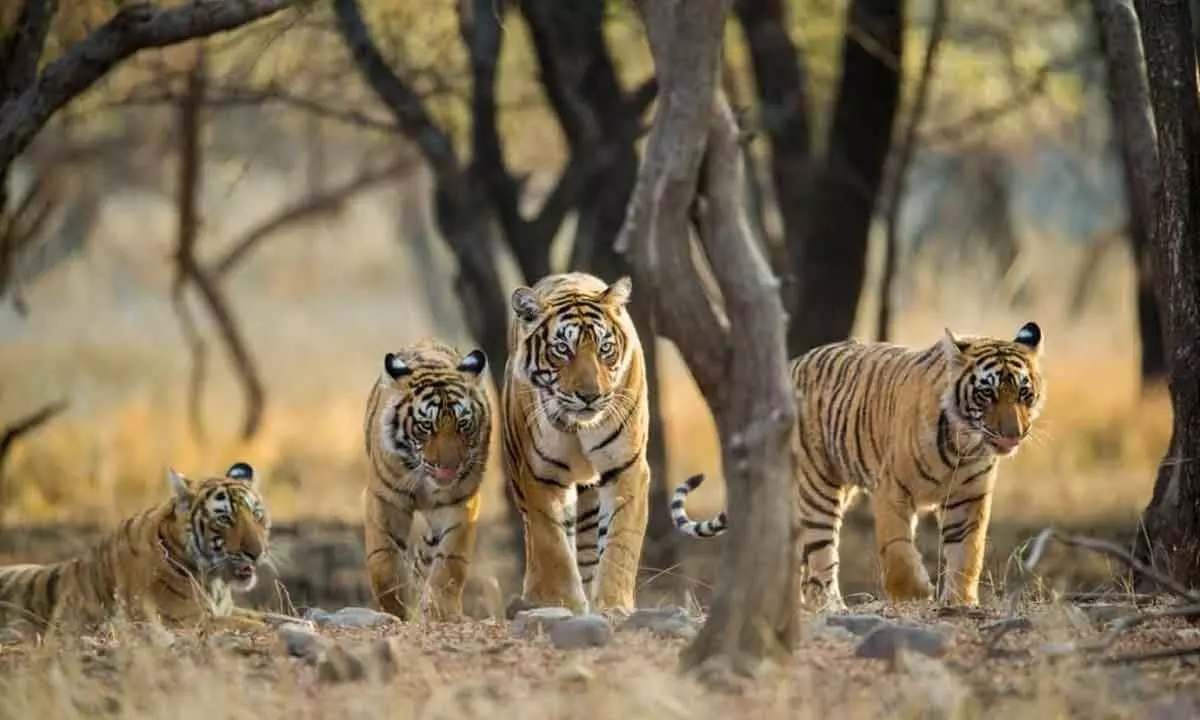Telangana State tiger population on wane; need for prompt action stressed

Hyderabad: In a concerning revelation, the latest report on ‘Status of Tigers’ 2022, indicates a distressing decline in Telangana’s tiger population. With various factors posing a threat to these majestic creatures, urgent and robust conservation efforts have become imperative to safeguard their existence. The report attributes the decline in tiger numbers to a range of factors, including habitat loss due to human encroachment, and a disruption in the delicate ecosystem balance amongst various other factors.
Telangana, renowned for its rich forest cover accounting for approximately 24.70 percent of its total geographic area (as reported in the State of the Forest Report 2021), has been a vital habitat for the majestic tiger population. However, a recently released report unveiled a distressing decline in tiger occupancy within the State.
In the past, lush forests like Kawal and Eturnagaram were well-known for being home to thriving tiger communities. However, the year 2022 brought with it shocking news, as no tiger presence was recorded in these once-bustling areas.
The Telangana tiger population can be categorised into two regions. The picturesque landscapes of northern Telangana, bordering Chhattisgarh and Maharashtra, were once teeming with vibrant tiger population. However, these tigers are now part of a larger tiger-occupied landscape known as Tadoba-NNTR-Indravati, which extends across the States of Chhattisgarh, Maharashtra, and Telangana. This interconnected habitat highlights the need for cooperative efforts among States to ensure the conservation of these majestic creatures.
Presently, the tiger population in this region is facing a severe depletion, with only a few surviving in Kagaznagar. Alarmingly, no tigers were detected in the once-thriving Kawal Tiger Reserve, signaling a distressing loss in biodiversity. Tiger population in Kawal tiger reserve is locally extirpated and currently no tiger presence was reported. However, four adults and three cubs were photo-captured in the Kawal corridor (in Kagaznagar) within the greater Kawal landscape can act as a source for recovery. The department has put lot of efforts into habitat management and a prey recovery programme is underway. This tiger reserve should be conserved to maintain the genetic heterogeneity of tigers of Tadoba meta-population block. To ensure the recovery of this Tiger Reserve, it is essential to invest in various conservation measures. Active management initiatives such as improved law enforcement monitoring, incentivised voluntary relocation of human settlements, community engagement through participatory community benefits, supplementation of prey, followed by reintroduction of spill-over tiger population from Tadoba meta-population could eventually help in colonising tigers in this tiger reserve, mentions the report.
In the picturesque southern region of Telangana lies the Amrabad Tiger Reserve, contiguous with the Nagarjunasagar Srisailam Tiger Reserve, hosting the largest tiger population in the State. However, this haven for tigers faces significant challenges, necessitating effective interstate cooperation with Andhra Pradesh for successful management.
Amrabad Tiger Reserve was part of the Greater Nagarjuna Srisailam Tiger Reserve before the reorganisation of Andhra Pradesh. It is situated in the Nallamala Hills of the Eastern Ghats of Telangana State. The reserve extends till Mahabubnagar and Nalgonda districts and is about 150 km south of Hyderabad on the southern bank of the Krishna. The core covers a total area of 2166.37 sq.km and has a buffer area of 445.02 sq km
Tragically, even within the Amrabad region, the presence of tigers has been declining, sounding an urgent call for action. A multitude of threats loom over the tiger landscape in Telangana, including rampant poaching of prey, destructive mining operations, and the relentless development of linear infrastructure, the report says.
To safeguard these magnificent animals, immediate environmental protection measures are crucial. Adopting sustainable mining practices and promoting environmentally friendly methods can curtail the detrimental impacts of mining operations on tiger habitats. Additionally, the establishment of wildlife passageways will allow these awe-inspiring creatures to roam freely and maintain vital genetic diversity.
Mitigating the threats that these tigers face demands a unified front. Concerted efforts in conservation and habitat protection are essential to secure their long-term survival. Collaborating closely with neighboring Andhra Pradesh is indispensable to ensure a comprehensive approach to tiger conservation.
















